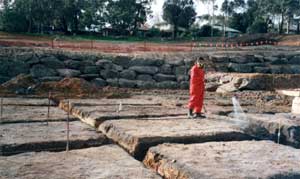Building Sites
 Wheter
it's a single house, a shopping centre or a 1,200 home development, the
builder's reputation is on the line with each building. We understand
this - and do our part to protect it.
Wheter
it's a single house, a shopping centre or a 1,200 home development, the
builder's reputation is on the line with each building. We understand
this - and do our part to protect it.
Here is an outline of what we do:
1. Review the site
We take a few minutes with the builder to visit a site that's about to have the slab poured and review the areas (discussed on the previous page) that can cause problems with the termite barrier.
2. Review the barrier
We review the barrier with the builder and show that the right rate and right volume and right product are used and applied evenly.
3. Scheduling
Ideally the application should be made to the site after all of the work inside the area where the slab will be poured will be done. This will mean no disturbance to the barrier. We then need to know the builder's schedule. This is also a good time to discuss pretreating the footing area and around the edges of the footing after it has been poured.
4. Knowing when things get done and how they're done
We are familiar with all of the operations that go on at a building site, and spend time at the site.
5. We inform subcontractors
Often someone will have some work to do after pretreatment. We inform these people of the pretreatment, and what happens if this barrier is disturbed.
6. Moisture Membrane Installation
We inform the builder and concretor that the vapour barrier should be installed immediately after the treatment. Installers of the Moisture Membrane must wear appropriate personal protective equipment. If necessary we will show the installers the label requirement.
7. Legal obligations
We remind the builder that we have been issued with an Agreement Number to use Biflex that places a legal obligation on us to use Biflex in accordance with the label and AS3660.1 requirements. We also remind the builder that he too has a legal obligation to ensure that the pretreatment service is done correctly and not disturbed. After all, the warranty he issues the homeowner declares that all the work undertaken complies with recognised practices.
Did You Know?
Biflex is now registered for a wide range of general pests. Biflex has been registered in Australia for the control of subterranean termites since July 1995. The label was expanded in October 1999 to include the use of the product against spiders. Biflex has now been approved by the National Registration Authority (NRA) for the control of a range of other general pests including ants, cockroaches, fleas, flies, mosquitoes, papernest wasps and ticks.